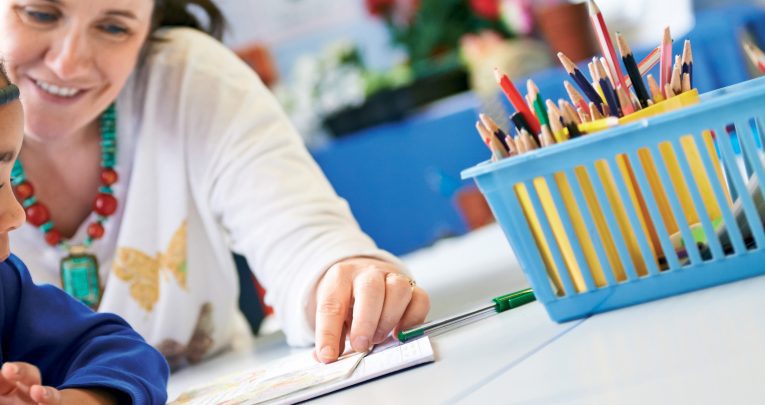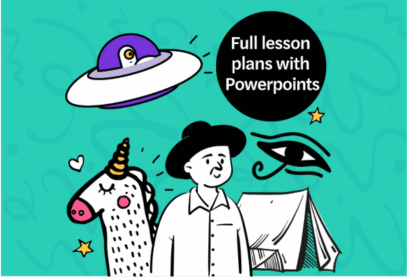Pie Corbett – How to use the shared writing approach

Teach children to become better writers by using Pie Corbett’s shared writing approach in your classroom…

- by Pie Corbett
- Inspirational trainer, poet, author and editor of over 250 books Visit website

Learn how to use the Pie Corbett shared writing approach to guide pupils towards writing their own creative compositions…
Who is Pie Corbett?
Pie Corbett is an English educational trainer, writer, author and poet who has written over 200 books. Teachers love him for the way that he promotes creative approaches in the classroom. He is an experienced teacher, headteacher and Ofsted inspector.
What is shared writing?
Shared writing lies at the heart of teaching writing. This is the generic term for writing with and in front of children as a precursor to the class writing more independently.
It is the key moment at which writing is taught. If you don’t do shared writing, you’re not teaching writing.
You’ll use your assessment of children’s writing to decide on the key ‘progress points’ that you need to focus on during shared writing. This may be aspects of composition (eg using a short sentence for impact or handling speech marks) or a more general aspect of writing behaviour (eg using a plan to develop a plot).
“If you don’t do shared writing, you’re not teaching writing”
There are two key, interrelated processes – ‘demonstration’ and ‘joint composition’. You need to pitch shared writing about one level above children’s own writing so that they are constantly engaged in progress.
Free Pie Corbett teaching resources

Download our Pie Corbett Ultimate KS2 Fiction Collection which contains 20+ fictional stories with accompanying lesson plans. Explore the included story then ask children to write their own versions…
The stages of Pie Corbett shared writing
- Demonstration I’ll show you how to do something
- Joint composition Now we’ll have a go together
- Guided writing I’ll support you in a small, focused group
1. Demonstration
This is where you show children how to do something in writing that is new, or difficult, and will help pupils make progress. You write in front of the children on a flip chart. You give a running commentary as you go, revealing the decisions you’re making.
This way, the children are witnessing a writer at work. Aim to make this part well focused and fairly brisk so that it holds children’s attention.
Talk 4 Writing with Pie Corbett in grade 5. Working on suspense writing with shared writing! #superfun pic.twitter.com/x7uu1rqNpG
— Sean Andersen (@mrseanandersen) February 3, 2018
Centre on the key aspects that you need to teach. Try to avoid too many ‘useful comments’ that cloud the objectives.
Use coloured pens to make progress points stand out. As you write, invite children to offer comments and suggestions so that they are fully engaged and not just passive observers.
2. Joint composition
This is similar, except the children begin to take control, with you scribing their ideas. If ‘demonstration writing’ is ‘I’ll show you and explain’, then ‘joint composition’ is ‘Now let’s have a go together and you explain’.
There is a shift from the teacher as model towards the children doing more of the thinking, composing, explaining and working as writers.
Your job is to write down what children say on a flip chart, taking over the transcription. You’ll also need to remind, prompt and challenge, so that children’s writing remains focused on your progress points.
You need to constantly balance the focus between pushing children to ‘generate’ ideas and then ‘judging’ what works best. Pause to reread and listen to the flow of the composition.
We read back to help us write on. What ends up on the board has to be the best work you can elicit from the children. In the same way, when children write their own version independently, what they end up with on their page has to be the best they can find within themselves.
“What ends up on the board has to be the best work you can elicit from the children”
The pace needs to be brisk, but have pauses for ‘thinking time’. On some occasions you may refer back to the model text to remind children of what effective writing sounds like, or to check a certain technique.
Children can use magpie books to jot down ideas. Ask your teaching assistant to create a word bank, listing everyone’s suggestions.
From dependence to independence
Formative assessment is taking place virtually all the time while you teach your class. It’s your role to pick up on what is happening and constantly try to move the writing forward, deepening children’s understanding and engaging them.
Gradually you’ll take a step back so that children take on more and more responsibility, moving from dependence to independence.
Remember that if you analyse and explain too much, you can spoil the flow of joint composition. You’re aiming for a breathless sense of excitement as the text emerges. The key is to encourage the children to suggest ideas, test them out and then press on.
“You’re aiming for a breathless sense of excitement as the text emerges”
As the teacher, you are the gatekeeper of quality. Don’t accept anything shoddy. Remind the children of the key features they need to use in order to ensure progress.
Try pausing to hear several ideas and then ask the children to choose which they think will work best – and explain why.
Through constant teaching, these complex writing processes eventually become increasingly well-orchestrated, internalised and automatic, especially where such processes are articulated.
It is saying difficult things aloud that helps us all, in the end, to be able to say them silently in our heads. Eventually, the children hear the questions they need to ask. Aspects of writing become an automatic part of their repertoire.
They find they can hold an internal dialogue with themselves about the choices available and consider how effective a particular word or phrase will be, or how well their writing rereads. Writing processes have to become automatic habits.
3. Guided writing
This is a form of group teaching where you focus on children who have similar needs. This is based on your assessment of their writing and observing how they write.
‘Guide’ the group through the part of the writing process that everyone else is focused upon. For example, if the class is working on the ‘opening’ to a story, then your guided session will also focus on guiding the group through writing their openings.
Help children remind themselves of targets, progress points and writing processes. Revisit the model and toolkit. Try writing on mini whiteboards. This is because children are more likely to experiment. They can then copy the work into their journals.
Re-reading
The main point about guided work is that the children should be doing most of the thinking and writing. It is a scaffolded bridge from dependence towards independence.
Take time to reflect. Writers nearly always read their work aloud, and this is an important habit to develop with children. You read your work aloud primarily to ‘listen’ to it – to hear how it sounds, whether it flows and the effect it creates.
“The children should be doing most of the thinking and writing”
Make it a habit to always re-read a paragraph through and ask the children the following questions:
- Which are the best bits and why?
- Are there any places we could improve?
- Are there any mistakes?
This begins to develop the habit of editing and proofreading. Finally, at the end of the session, it is worth asking:
- What have we learned about writing?
- To write this really effectively, what did we have to do?
List down children’s ideas as part of your writing toolkit. This final reflection can capture matters of technique (we had to use ‘show and not tell’) as well as writing habits (we had to concentrate).
It’s worth typing up the shared writing so that children can stick it into their journals. This is both for children’s pleasure and so that they can reference it when they’re writing.
Follow Pie Corbett on Twitter at @PieCorbett. Browse more ideas for National Writing Day.







